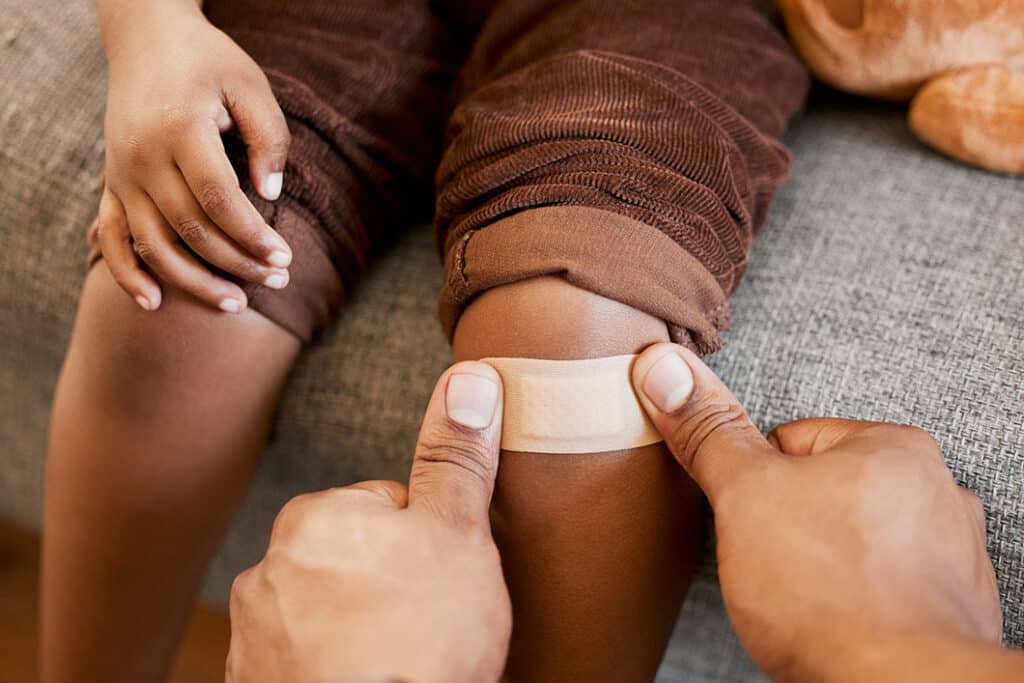Treating Scrapes Like a Pro

Scrapes, cuts, and burns are inevitable, which is why you should know how to treat them. From keeping the scrape clean to providing long-lasting relief, we'll show you how to care for a common scrape.
In this guide, you'll learn what to do after a fall or scrape, must-have products for your first aid kit, and how to recover fast!
What is a Scrape?
Common scrapes, also known as abrasions, appear as superficial wounds on the surface of the skin. They exhibit redness and swelling around the injured area. This is part of the body's natural healing process and simply indicates blood flow to the part of the body. Minor bleeding may also occur, particularly if the skin is broken or if small blood vessels near the surface are affected.
The most noticeable symptom of a scrape is the visible abrasion on the skin's surface, which may present as scraped or grazed skin, often exposing the underlying tissue.
Scrapes can be painful, especially if they occur in sensitive areas of the body or if they become dirty. The severity of pain depends on the individual and the extent of the scrape. Overall, common scrapes are superficial wounds characterized by redness, swelling, minor bleeding, surface abrasions, and varying levels of discomfort.
What to Put on a Scraped Knee
Scraped knees are a common occurrence, especially for active individuals or children. Proper treatment is essential for preventing infection and promoting healing. Here's what to do:
- Cleanse the Wound: Begin by gently rinsing the scraped knee with clean water to remove dirt and debris. Avoid using harsh cleansers or hydrogen peroxide that may irritate the skin and delay healing.
- Apply NuNature First Aid Gel: Once the wound is clean and dry, apply NuNature First Aid Gel to the scraped area. Its antiseptic properties will help kill germs and prevent infection, while lidocaine provides instant pain relief.
- Cover with a Bandage: After applying the gel, cover the scraped knee with a sterile bandage to protect it from further irritation and contamination. Change the bandage regularly to keep the wound clean and promote healing.
- Monitor for Signs of Infection: Check the scraped knee for any signs of infection, such as increased redness, swelling, or pus. If you notice any signs of infection, seek medical attention promptly.
What is Lidocaine?
Lidocaine, a local anesthetic frequently used to numb specific areas of the body, plays a crucial role in treating scrapes by alleviating pain and discomfort. It is also a main ingredient in NuNature First Aid Gel.
When applied topically to the affected area, lidocaine obstructs the transmission of nerve signals. By blocking sodium channels on nerve fibers, lidocaine stops pain signals to the brain, resulting in a numbing effect. This rapid onset of action offers immediate relief from pain associated with scrapes, making it easier for individuals to manage their injuries.
Furthermore, lidocaine provides extended pain relief, ensuring comfort throughout the healing process. Its long-lasting effect allows individuals to continue their daily activities without being hindered by discomfort from the scrape. By improving comfort during healing, lidocaine promotes better wound care practices, such as cleansing and dressing changes, which contribute to faster recovery times.
The Benefits of Antiseptics
Antiseptics are crucial for preventing infection in minor wounds. Unlike antibiotics, which target specific bacterial infections, antiseptics work to kill or inhibit the growth of bacteria on the skin's surface. By applying antiseptics like those found in NuNature First Aid Gel soon after an injury occurs, you can minimize the risk of infection and promote faster healing.
Minor wounds are a part of life, but with the right first-aid treatment, they don't have to slow you down. With NuNature First Aid Gel, you can treat scrapes, cuts, and burns like a pro, thanks to its potent antiseptic formula and lidocaine for pain relief.




